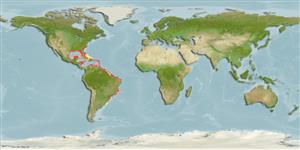Common names from other countries
Classification / Names / Names
Nomi Comuni | Sinonimi | Catalog of Fishes (gen., sp.) | ITIS | CoL | WoRMS
Environment: milieu / climate zone / depth range / distribution range
Ecologia
Benthopelagico; salmastro; distribuzione batimetrica 0 - 75 m (Ref. 367). Tropical, preferred 26°C (Ref. 107945); 35°N - 38°S, 98°W - 34°W
Western Atlantic: USA to Argentina.
Length at first maturity / Size / Peso / Age
Maturity: Lm 59.5 range ? - ? cm Max length : 13.9 cm CW maschio/sesso non determinato; (Ref. 367); 11.3 cm CW (female); Età massima riportata: 2.50 anni (Ref. 85497)
Carapace slightly more than twice as broad as long; 9 teeth on arched anterolateral margin 9outer orbital tooth and strong lateral spine included) progressively more acuminate laterally; outer pair of frontal teeth (excluding inner orbital angles) prominent but inner pair small. Much of convex dorsal surface lightly granulate, most prominently so on anterior and elevated areas and in transverse lines; central trapezoidal (metagastric) area short and wide (anterior width about 2 to 2.5 times, posterior width about 1.5 times length). Pincers dissimilar, ridged longitudinally; fifth legs flattened in form of paddles. Male with T-shaped abdomen reaching slightly beyond suture between thoracic sternites 4 and 5; first pleopods reaching beyond midpoint of thoracic 6, nearly straight distally except for merabranous tips usually bent ventrolaterally, armed with scattered, minute, mainly dorsal spinules and 2 to 4 subterminal, exceedingly slender, elongate sternomesial spinules. Color: variably olive to greyish blue dorsally, spines olive to indigo and white-tipped; pincers with variable blue to purple on upper and inner surfaces, olive to blue externally; legs predominantly dark blue to azure or greenish, underparts white. Some individuals are duller and some have a reticulate pinkish blue cast on the upper surface of chelipeds.
Minimum carapace width: 3 cm (Ref. 93549). Maximum length of female from Ref. 85497.
Life cycle and mating behavior
Maturità | Riproduzione | Deposizione | Uova | Fecundity | Larve
Members of the order Decapoda are mostly gonochoric. Mating behavior: Precopulatory courtship ritual is common (through olfactory and tactile cues); usually indirect sperm transfer.
Tavares, M. 2003. (Ref. 367)
IUCN Red List Status (Ref. 130435: Version 2024-1)
CITES status (Ref. 108899)
Not Evaluated
Not Evaluated
Human uses
Pesca: commerciale
FAO - pesca: landings | FishSource | Sea Around Us
Strumenti
Fonti Internet
Estimates based on models
Preferred temperature
(Ref.
115969): 23.3 - 28, mean 26.1 (based on 500 cells).
Resilienza
Alto, tempo minimo di raddoppiamento della popolazione meno di 15 mesi (K=1.83; tmax=2.5).
Vulnerability
Low vulnerability (16 of 100).
